Water
Water is a vital component of successful agriculture. Sufficient amounts of clean, usable water enable crops and livestock to thrive. Aside from agricultural benefits, water is also necessary to preserve the environments of many sensitive or protected lands such as wetlands.
Get Assistance for Your Conservation Issues
Review common water problems below and add issues you may be experiencing to My Conservation Concerns List. If you are experiencing other types of problems, continue to build your list by exploring the categories at the bottom of each page.
When you’re done, click Build Your List to finalize your list and get connected with free assistance from our conservation experts.
Note: NRCS is not a regulatory agency. None of your answers will be recorded or reported.
Locate Your USDA Service Center

Service Centers Found for County
Select one or multiple Service Centers.
Excess Water
Ponding and flooding
Excess water in soil can cause issues such as ponding, flooding, and other drainage issues. If left untreated, these issues can make it impossible to grow vegetation or crops and make buildings or structures more prone to flooding.
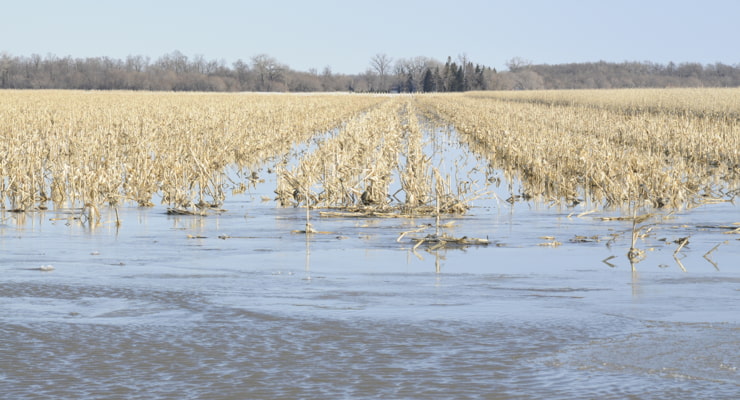
Flooding in North Dakota
Causes
- Ponding and seeps
- Stormwater runoff
- Flood prone areas
Possible Solutions
- Drainage management and structures for water control
- Roof runoff structures and capture for reuse methods
- Floodplain management
- Wetland restoration or enhancement
- Windbreak placement for protection and to provide access
- Water and Sediment Control Basin
Resources
Seasonal high water table
A water table is where saturated sediment meets unsaturated sediment underground. Water table levels can change depending on a number of factors including precipitation rates, soil permeability, drainage patterns, and more.
Seasonal high water tables occur when seasonal precipitation, such as an overly wet season, causes groundwater or a perched water table to over-saturate the soil near its surface. This can degrade water resources or prohibit land from being used as intended.
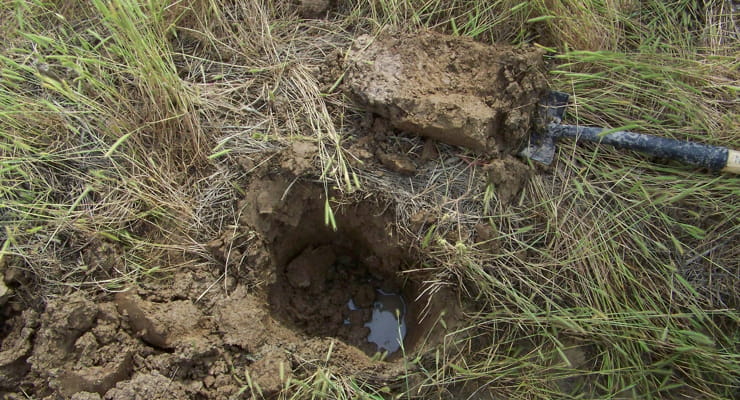
Example of seasonal high water table
Causes
- Precipitation rates
- Soil permeability
- Geological formations
- Drainage patterns
- Human impacts
- Proximity to nearby surface waters
Possible Solutions
- Manage seasonal excess water with surface or subsurface drainage practices
- Implement wetland restorative and enhancing practices to promote wetland function, value, habitat, and diversity to pre-disturbance conditions
Water seeps
Seeps occur when subsurface water gradually reaches the earth’s surface creating areas of moisture on land. Water seeps can restrict plant growth, degrade water resources, and cause damage in or around buildings, among other problems.
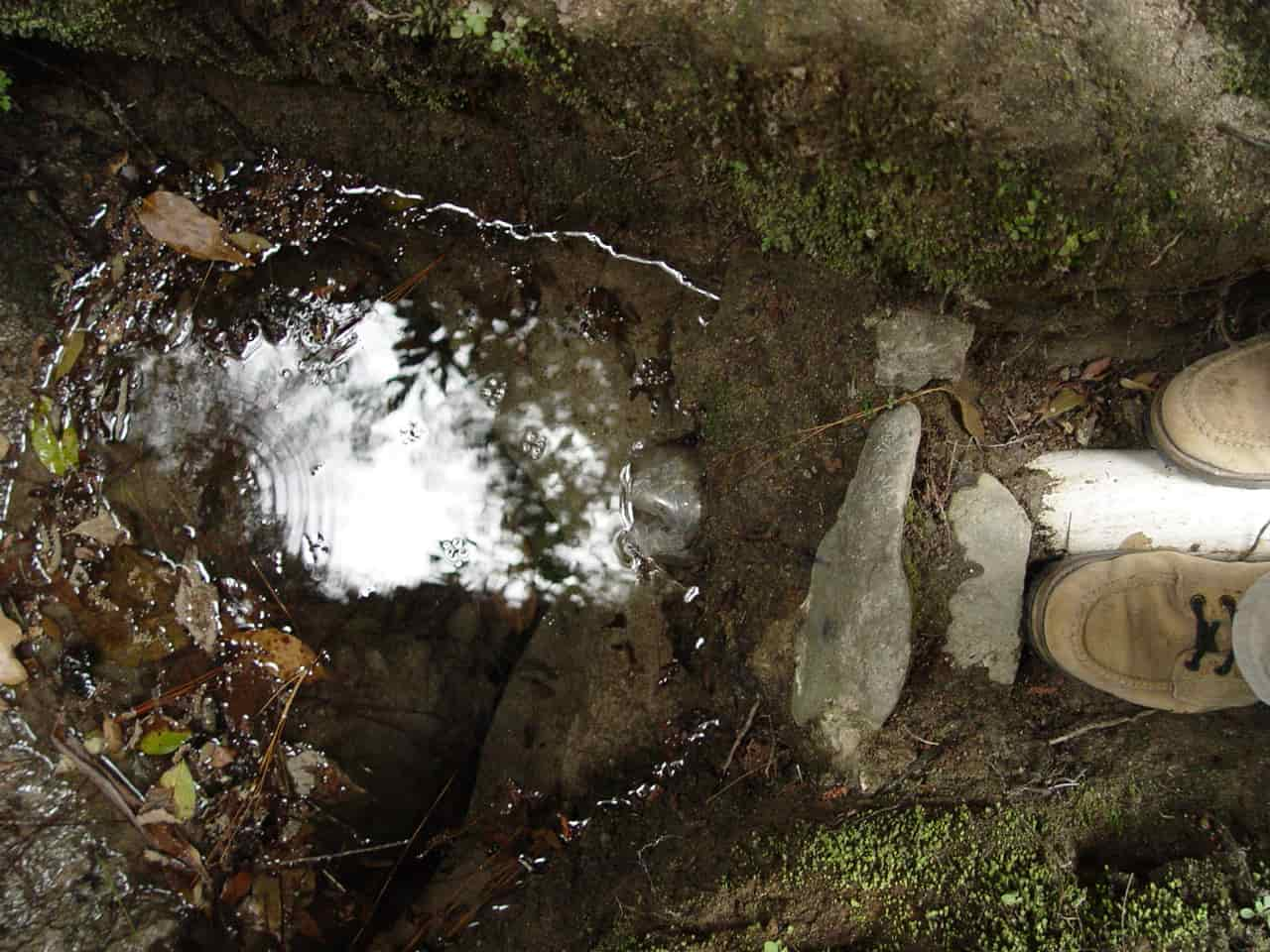
Example of a water seep
Causes
- High water table
- Natural soil conditions
- Sub surface water due to prior development or land shaping
Possible Solutions
- Wetland restoration or enhancement
- Wet meadow management
- Drainage management and structures for water control
- Tree Planting, windbreak placement for water use and to provide access
Resources
Drifted snow
Wind can blow fallen snow and create mounds of snow called snowdrifts. Snowdrifts can cause hazardous conditions and can prohibit humans and animals from accessing structures or features.
Wind can also blow snow away from desired locations where snowmelt water can be used. Managing snowdrift locations to capture snowmelt can benefit soil moisture and increase crop productivity.
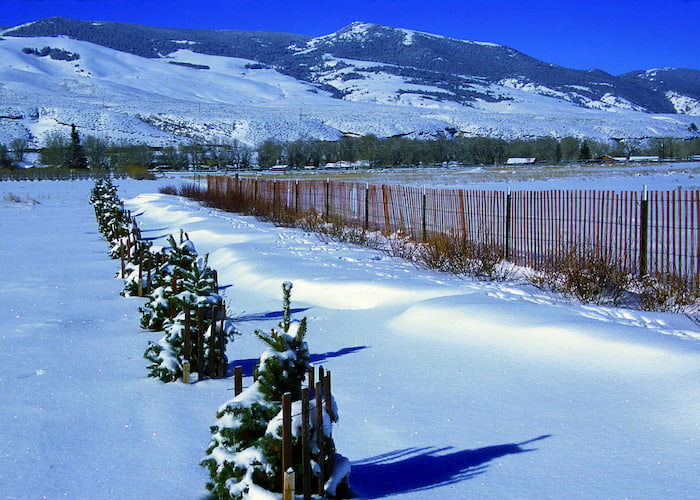
Example of a snow drift
Causes
- Blowing snow encounters barriers such as terrain, structures, and vegetation, and snowdrifts form where the wind is slowed, typically in leeward positions. Snowdrifts may be small or large depending on snowfall amounts, wind speed and direction, and configuration of barriers.
Possible Solutions
- Living snow fences of trees and shrubs, sometimes doubling as windbreaks or shelterbelts, designed and placed to protect animals and structures, provide access, limit runoff, and benefit soil moisture
- Snow fences or other structures configured to diminish effects of drifting snow
- Conservation tillage practices that retain crop stubble or rough surface conditions help to spread accumulation of drifted snow on crop land.
Insufficient Water
Inefficient soil moisture management
Water is a vital component of farming and natural ecosystems. Inefficiently managing the moisture in soil can lead to poor crop yields and increased runoff. In cropland, poor yields could be attributed to an insufficiency of soil moisture instead of inadequate rainfall.
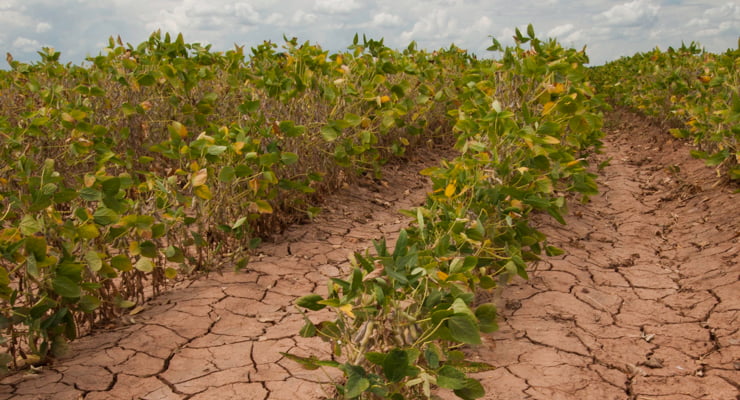
Soybeans in Navasota, Texas
Causes
- No soil cover in the winter to prevent moisture loss
- Excess soil tillage and disturbance destroys soil organic matter and structure
- Unchecked brush growth creating potential for less available moisture for desired plants
Possible Solutions
- Cover crops
- Conservation tillage
- Brush management
Resources
Inefficient use of irrigation water
If irrigation water is not stored, delivered, scheduled, or applied effectively, then it may not be used as efficiently as possible. In addition, aquifer depletion or drought can lead to low levels of surface or groundwater.
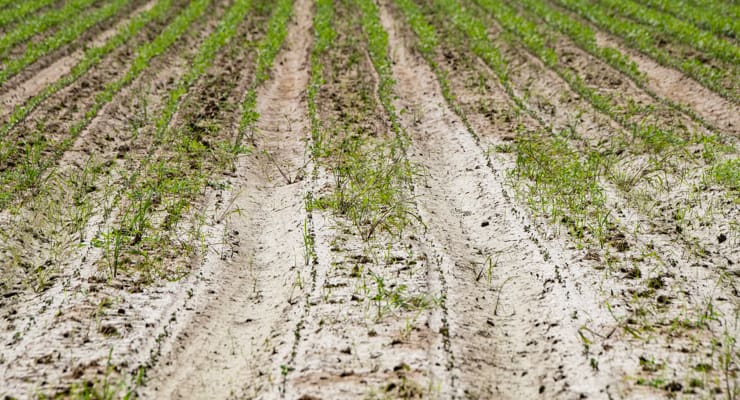
The result of too much water in a soybean field in DeValls Bluff, Arkansas
Causes
- Open earthen ditches
- Irrigation water allowed to run off of fields
- Losses due to improper system design, installation, or maintenance
Possible Solutions
- Line ditches or install pipe; improve water transport systems
- Manage applications to reduce runoff; tailwater return systems
- Audit system and retrofit or replace where warranted
Resources
Water depletion
Water depletion can occur in both surface water (ponds, lakes, pools from precipitation runoff, etc.) and groundwater. If water from either of these sources is used more quickly than it can be replenished, natural resources can be impacted and land may not be unusable for its intended purposes.
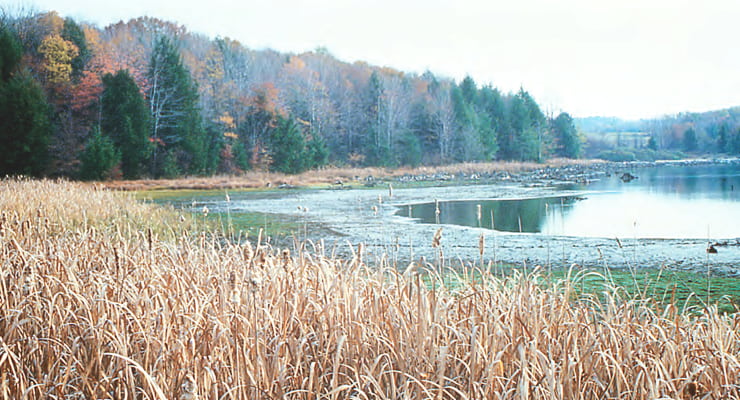
Example of water depletion in a pond
Causes
- The use of ground water at a rate greater than aquifer recharge
- The use of surface water at a rate greater than surface water body replenishment
Possible Solutions
- Manage water withdrawal rates to avoid perpetuating natural resource concerns
- Implement conservation practices that recharge groundwater resources such as water harvesting catchment facilities and rain gardens
- Implement conservation practices that develop and replenish surface water resources such as tailwater recovery irrigation systems and irrigation reservoirs
- Properly dispose of agricultural chemicals and waste to avoid water contamination
- Convert from lower efficiency to higher efficiency irrigation systems
- Decrease the baseline amount of water that crops require for growth by cultivating water-thrifty crops
Use of naturally available moisture
Soil moisture impacts plant growth, soil settling, susceptibility to compaction, ease of excavation, and installation of conservation practices. Soil moisture can be influenced by many factors including precipitation, temperature, wind, and more. Naturally available moisture should be managed to help support land use goals and ecological processes.
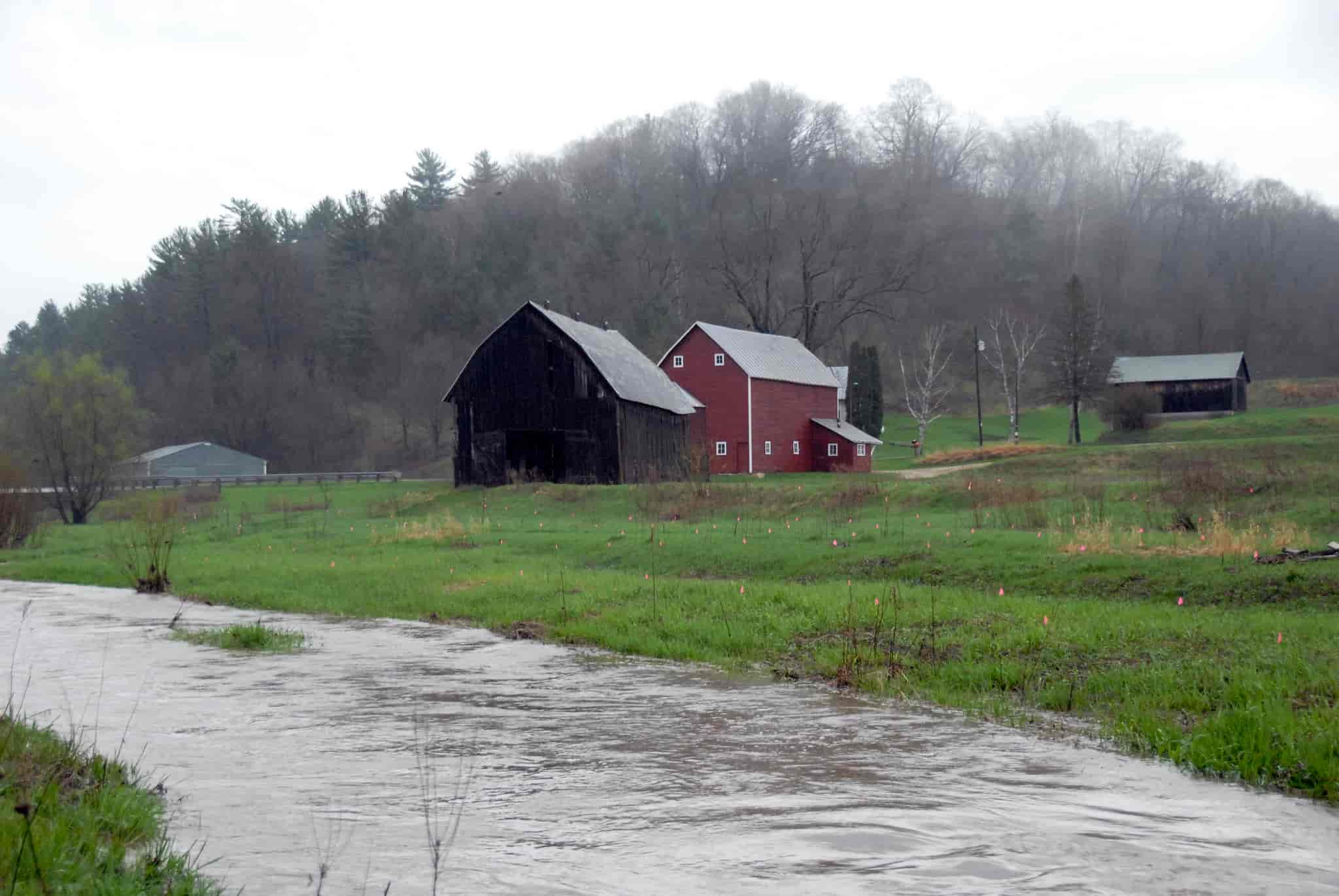
A rain-swollen stream flows through a farm in La Crosse, Wisconsin.
Causes
Misuse of naturally available moisture can be caused by:
- Clean or traditional tillage
- Unnaturally low organic matter
- Overgrazing of horses and livestock
Possible Solutions
- Use reduced/mulch tillage or no-till cropland strategies
- Increase soil organic matter by using cover crops, compost, and/or manure
- Reduce chemical inputs that kill naturally functioning organic components
- Manage grazing to optimize plant cover and re-growth to maintain roots for soil aggregation and improved water infiltration
Water Quality Issues
Elevated water temperature
As surface water temperatures rise above normal levels, gases important to aquatic life, such as oxygen and carbon dioxide, decrease. High water temperatures can also cause minerals that degrade water quality to dissolve.
In some areas, Federal or state laws may regulate surface water temperatures.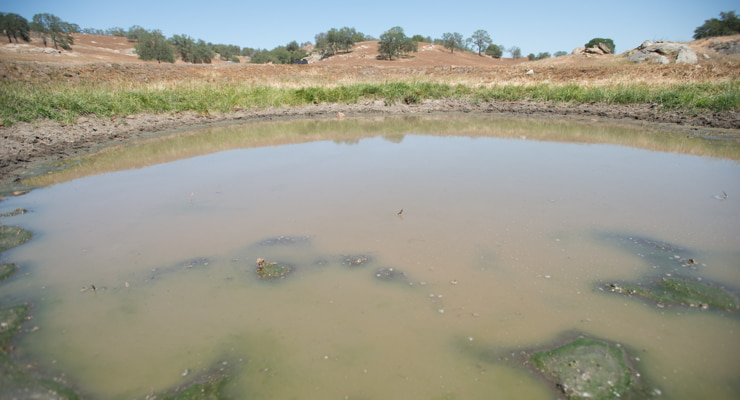
A pond in O’Neals, California lacks shade from direct sunlight
Causes
- Surface water unprotected from direct sunlight
- Little or no groundwater contribution to water body
- Sediment laden runoff reaching water body
Possible Solutions
- Reestablish riparian vegetation
- Brush management, residue management, terraces to reduce transpiration, evaporation and/or increase infiltration of upland water
- Buffers and filter strips to intercept sediment
Resources
Excess nutrients in water
Nutrients are transported to water through runoff into surface water and by leaching into ground waters. When the amount of nutrients making their way to water reaches a certain threshold, water quality begins to deteriorate.
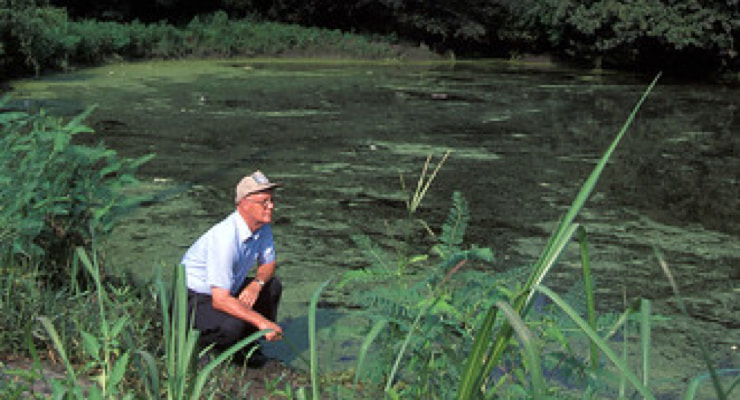
Algal bloom near Baton Rouge, Louisiana
Causes
- Overusing fertilizer (both residential and agricultural usage)
- Soluble nutrients
- Erosion of nutrient-laden soil
- Rainfall flowing over cropland, animal feeding operations and pastures, picking up animal waste and depositing it in water bodies
- Low organic matter
Possible Solutions
- Nutrient management to address the form, rate, placement and timing of nutrient application
- Cover crops
- Crop rotations
- Increased crop diversity
- Conservation buffers
- Residue management
Resources
Pathogens and chemicals in water
Pathogens, pharmaceuticals, and other chemicals that exist on the surface of soil can be transported to surface water and degrade water quality. These substances can also leach to existing groundwater supplies. These substances usually come from compost runoff or bio-solids and manure from animals.
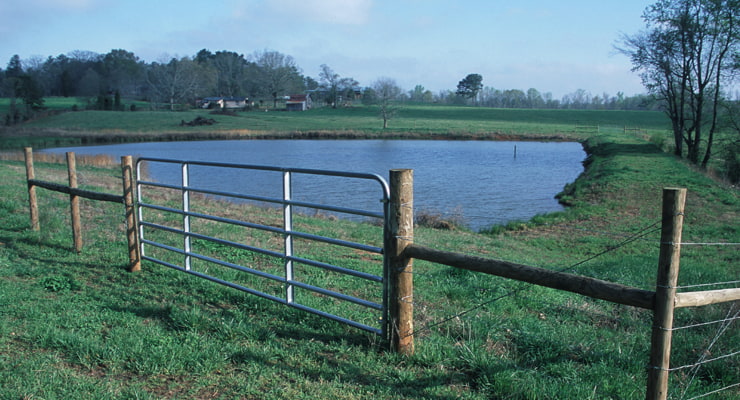
Wetland area restored and buffer protection from grazing livestock in Lyons, Georgia
Causes
- Collection, handling and storage of manure
- Land application of manure
Possible Solutions
- Biological treatment (anaerobic storage, composting, anaerobic digesters)
- Vegetative filter strips, setbacks and buffer zones
- Managing livestock access to water
- Managing the rate, timing, and method of application of manure
Pesticides in water
When pesticides are used in large quantities or near sensitive watersheds, they can be transported to both surface and groundwater in quantities that degrade the water quality. Water with problematic levels of pesticides can sometimes not be used for intended purposes and can also pose risks to animals and people.
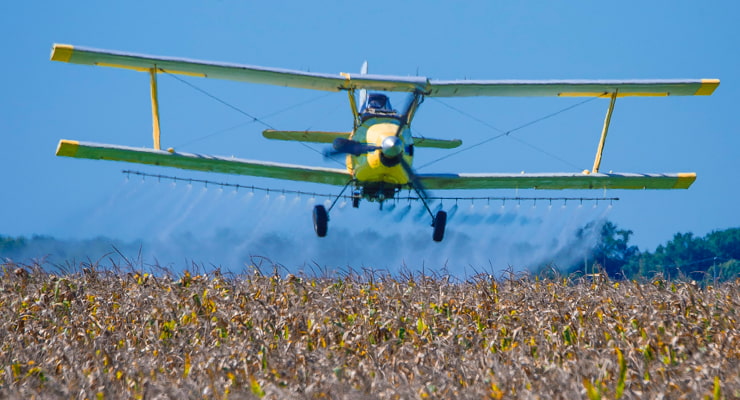
A crop duster lays down fungicide and insecticide in Chestertown, Maryland
Causes
- Pesticide use in sensitive watersheds
- Use of pesticides with intermediate or higher hazard risk
Possible Solutions
- Residue management
- Cover crops
- Conservation crop rotation
- Integrated pest management strategies
- Alternative pest suppression strategies
- Conservation buffers
- Proper use and storage
- Drainage water management
Pollutants in water
If heavy metals, petroleum, and other pollutants are not handled or stored properly, they can run off into surface water or leach into groundwater. In high amounts, these pollutants can degrade water quality which limits how this water can be used.
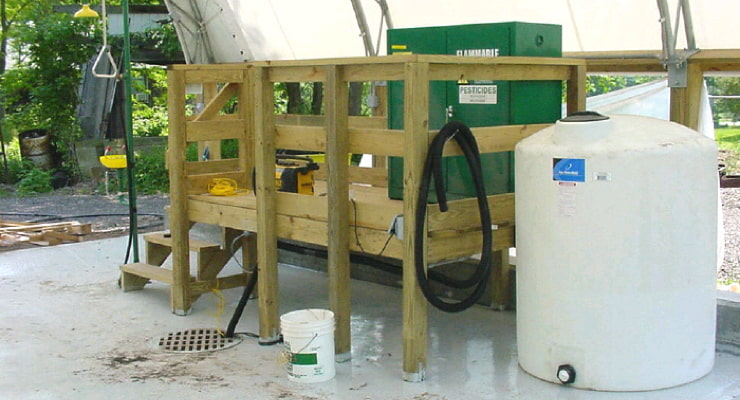
Causes
- Inadequate storage and handling
- Application of biosludge, contaminated animal manure, and artificial fertilizers
- Unprotected surface and groundwater sources
Possible Solutions
- Proper storage and handling
- Petroleum and chemical containment systems
- Proper application and use of animal manure biosludge and artificial fertilizer
- Protection of surface and groundwater sources
- Conservation buffers and application setbacks
Excess salts in water
Irrigation or runoff can cause soluble salts (that occur either naturally or unnaturally) in soil or shallow groundwater to be transported to surface and groundwater supplies. When levels of soluble salts reach problematic levels, water quality can become degraded and its usage can become limited.
Soluble salts include sulfates of sodium, calcium, and magnesium.
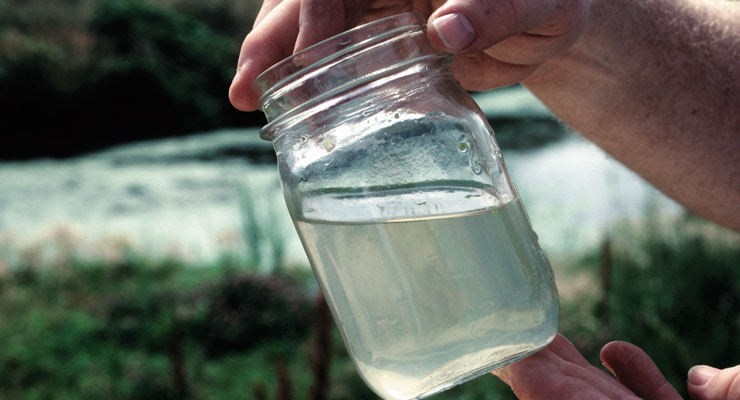
A scientist inspects a water sample
Causes
- Naturally occurring in soils with concentrations of soluble salts, such as sulfates of sodium, calcium, and magnesium in the soil
- Inadequate drainage to leach salt from the soil
- Upward migration of salt from shallow ground water
- Application of saline water
Possible Solutions
- Proper use of irrigation water
- Salt-tolerant crops
- Removal of excess water from recharge areas
- Maintain water table at a safe levels
- Cropping and tillage systems that promote adequate infiltration and permeability
- Reducing deep tillage
Excess sediment in water
Wind erosion and water (sheet, rill, or gully) erosion can cause sediment to be transported to surface water. When excessive levels of fine sediment enter the water, the water can become cloudy or hazy (turbid) or the sediment will slowly settle (sedimentation). Excess sediment can degrade water quality and limit the intended use of the water.
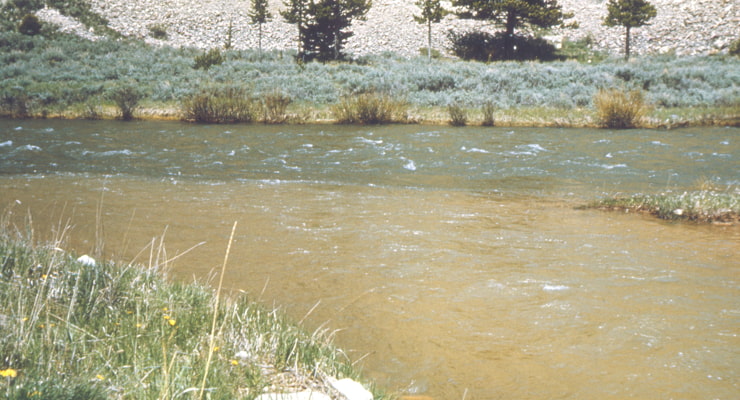
Sediment pollution in a river, Montana
Causes
- Bare or unprotected soil
- Long and steep slopes
- Intense rainfall or irrigation events when residue cover is at a minimum
- Decreased infiltration by compaction
Possible Solutions
- Residue management
- Crop rotations with high biomass crops
- Cover crops
- Terraces
- Strip cropping
- Windbreaks
- Buffers and filter strips to address the transport of sediment
Resources
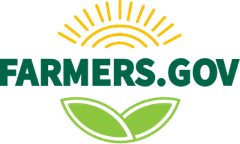

My Conservation Concerns List
The concerns you add will appear below. When you’re done adding issues, click the button below to finalize your list and find your local USDA Service Center.
